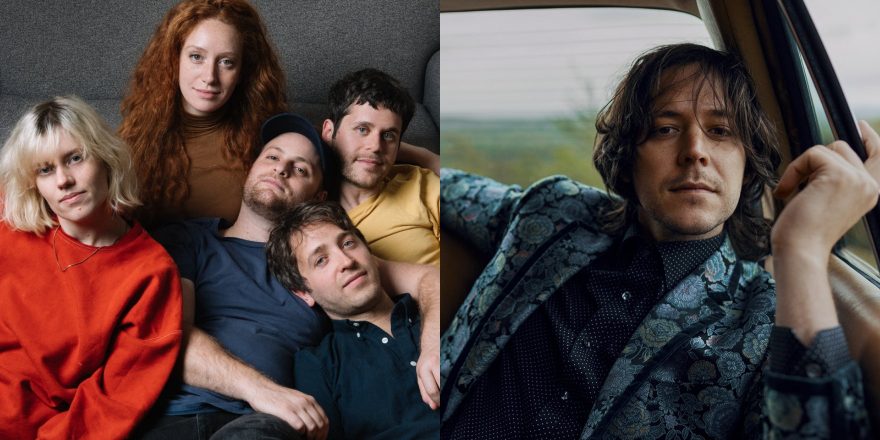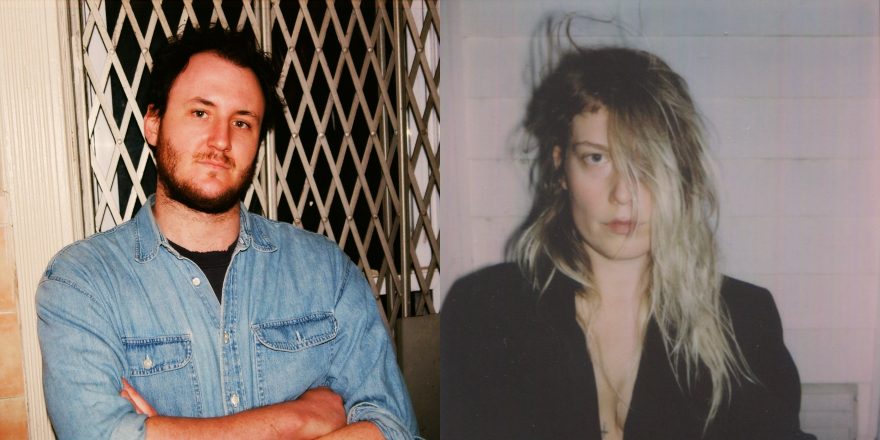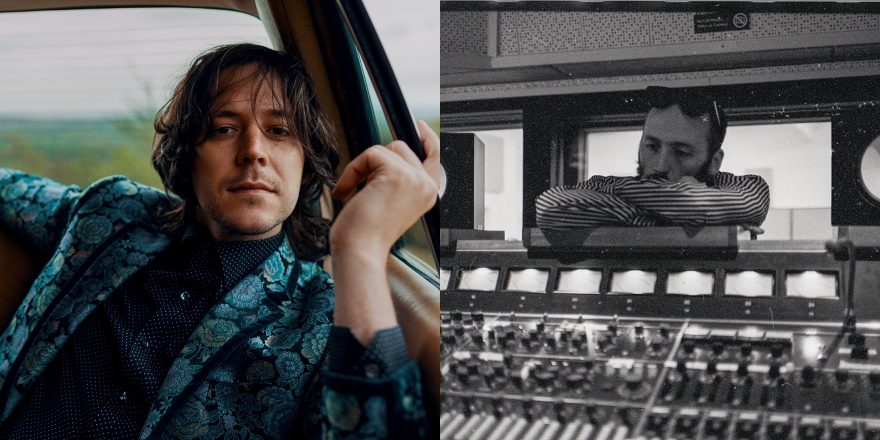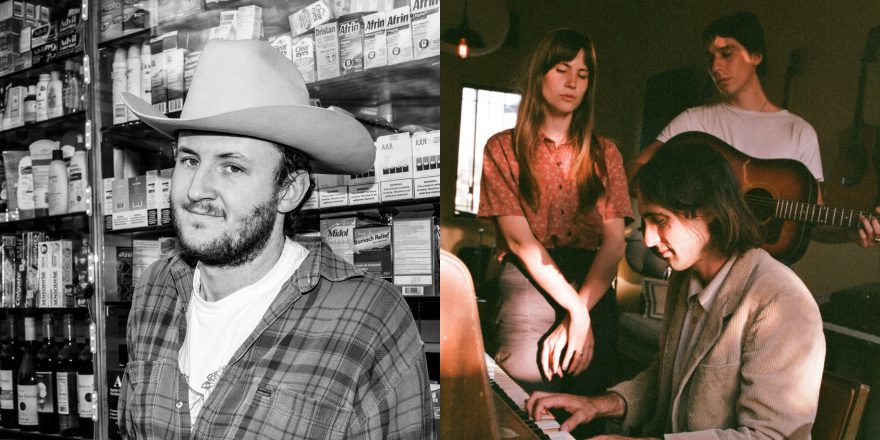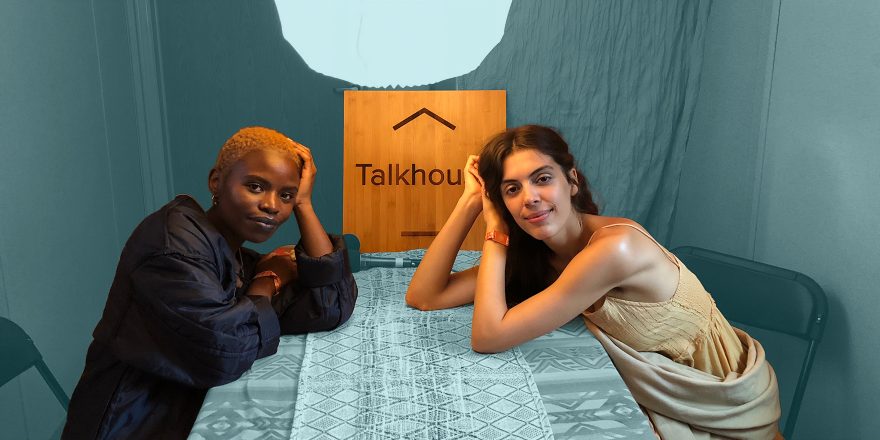Nate Mendelsohn is a New York-based multi-instrumentalist and recording engineer who performs with his band Market; Sam Evian is a songwriter and producer based in upstate New York. Ahead of Market’s new record, The Consistent Brutal Bullshit Gong — out April 29 on Western Vinyl — we’re premiering their single “Old,” which you can check out below along with a conversation between Nate and Sam.
— Annie Fell, Editor-in-chief, Talkhouse Music
Sam Evian: So how’s everything going with your record release?
Nate Mendelsohn: Good, it’s coming up in a few weeks. I’m stoked to have it out there. This Talkhouse feature is going to premiere “Old,” which I think is a kind of relevant song to what we’re talking about. It’s the only song on the record that’s about writing music and recording music — which I try to avoid generally. It was kind of a jokey country song that I wrote, and I never wanted it to be a real song. Then in rehearsal one day, Steve [Becker] was like, “We should play that country song.” And now it’s my favorite, of course, because the joke songs always are the most fun.
Sam: I love that song. It’s got that fun snare vibe, the boom-bop. I’m trying to think of other songs that reference the medium…
Nate: Yeah, it’s funny when people write songs about writing songs. I feel like there are Leonard Cohen songs [like that].
Sam: I feel like there are country songs that do that. I feel like there’s some songs that George Jones would sing that would be referencing the song itself.
Nate: Yeah. It can be great, but sometimes I get worried about it being kind of insular, like musicians making music for musicians or something.
Sam: Well, let’s be real, that’s what we do. [Laughs.]
Nate: [Laughs.] Hey, I played a show at Baby’s last night, I’m well aware. It was just all my music friends coming to hang out.
Sam: I don’t think it’s wrong to admit that you do things for your peers. I think there’s a history of that in music, despite it being maybe uncool to technically be doing that. I don’t know what. Why else would you be doing it? I think it’s weird to write songs for people.
Nate: [Laughs.] You want to write songs only for…
Sam: They’re for me, you know.
Nate: Yeah, well, that’s a whole other question. I think that’s part of why this song ended up being really fun for me, because it felt more relaxed and goofy. It wasn’t supposed to take itself too seriously or present itself a certain way. It was just this song about how you write a song, and then months later you rehearse it with the band, and then months later you record it, and then months later it gets mixed, and months later it gets mastered, and months later it comes out. Then by the time it comes out, it’s like, Who was I when I wrote this song? It’s like a lifetime ago. I like that it came out kind of low-pressure and goofy. Maybe we should be doing less worrying about writing songs for people and more just writing goofy, uninhibited songs.
Sam: Well, it’s interesting, because they’re always going to become like a time capsule, right?
Nate: Yeah.
Sam: You should write a song for your future self. You should write a song that you know you’re going to have to be dealing with in, like, eight to twelve months.
Nate: Better write a song that will be more relevant then for you than now. I’m going to write a song that’s, like, about my wife and kids. [Laughs.] About paying my mortgage.
Sam: [Laughs.] Maybe you could even plant things in songs that have some statistical odd of a chance of happening. Get some machine prediction models going.
Nate: In the music industry today, you need to stay really cutting edge, so you have to write about realities that haven’t even happened.
Sam: Yeah, you have to become a fortune teller. So, how did we meet?
Nate: Do you remember?
Sam: Didn’t I meet you at Oberlin?
Nate: Yeah, at your show with Deerhoof and Awkwafina.
Sam: I remember this show. That was a special tour for me because I had been a Deerhoof devotee. That was a big one. That was like a going on tour with the heroes kind of situation. 2014?
Nate: That sounds about right. I was already a Deerhoof fan, but I’d never seen them live, and I think I became a Deerhoof devotee that night. I was right up front and just had my mind blown off.
Sam: That’s how they get you.
Nate: And I think I remember you mentioning that night, “Oh, you guys are going to move to New York next year after you graduate? This studio, I’m helping them set it up…” [Sam was an engineer at Figure 8 Studios in Brooklyn.]
Sam: I was grooming you.
Nate: [Laughs.] Truly.
Sam: What a creep! [Laughs.]
Nate: It’s just what I needed! And I still came to New York, but I kind of resisted Figure 8 for like, nine months or something. But then finally I was like, OK, I should go intern there. And as soon as I got in there, I was pretty obsessed with the place.
Sam: Yeah, Figure 8 is special because everybody there was really self-aware in considering the type of environment that we wanted to cultivate, knowing the tropes of recording studios and how they can be spaces that are not necessarily inclusive, and can be like overtly masculine and obnoxious. Figure 8 was a little special safety zone, I think, where we were self-aware and did try to cultivate a productive environment for all sorts of people. I think we did a pretty good job at that in the beginning stages.
Nate: Yeah. Well, I think for starters, everybody there really focused on how it feels to be recording music and to be in a room together, much more so than like, it’s all about this microphone or this compressor, or this whatever. That’s kind of the starting point, being like, “What if stepping into a studio space didn’t have to feel any different than being in a room playing music?” But a lot of times, there’s another layer that might get people tripped up or be less welcoming.
Sam: Yeah, 100%. I think a lot of that comes from having the owner and founder of the studio, Shahzad Ismaily, be like a spiritual enigma — and super incredible musician, first and foremost — rather than a stressed out studio owner who’s like, hundreds of thousands of dollars in debt opening a new space.
Nate: He came to it with a different energy for sure.
Sam: Anyway, so we met at Oberlin, and then you came to work at Figure 8.
Nate: Mhm. I was interning, at first, for a while. I think I was probably the longest intern ever. I remember our manager at one point was like, “Do you want to stop interning? Like, you’re not getting paid. Are you OK?” And I was like, “No, I’m good. I’ll keep going.” [Laughs.]
Sam: Well, you were yearning to learn. I saw you putting the pieces together and figuring that shit out. It’s an investment, for sure, to move to a place where you’re confident and able to start making money from it. Turning it into your economy takes a minute.
Nate: It took me a long time, I think, to feel comfortable. I think it’s partially because I didn’t very quickly learn the lesson of like, it’s not really about a lot of the technical know-how — obviously that stuff is important, but I remember, the same moment where I started feeling really comfortable in the studio, running a session and knowing it was going to be a success, was the same moment when I was like, Oh yeah, you really just have to make people feel good and play good music and the rest is kind of gravy.
Sam: 100%.
Nate: I think that I learned some version of that lesson from everyone at the studio, but I’ve quoted you specifically many times — sometime really early on, you told me you thought 90% of the job was just two things: hospitality, making people feel comfortable, and troubleshooting, fixing things when they go wrong so that you can get back to recording music as quickly and with as little stress as possible. And then the last 10% maybe is like, “Oh, what microphone am I going to use,” and whatever.
Sam: For me, I say 90% hospitality and 10% troubleshooting.
Nate: [Laughs.] Oh, maybe I misremembered that. So 0% microphones.
Sam: Someone told me that when I was an intern. I worked for this man named Joe Salvatto — he was an old school engineer from Queens, he worked at Electric Lady and then he went and started his own recording studio in Midtown, and transitioned into building studios for people, which is where I learned how to do acoustic treatments and patch-based soldering — which is how I ended up getting involved with Figure 8. Anyway, he told me that the 90/10 rule, and I always remembered it.
Nate: Nice. And I always remembered it wrong.
Sam: [Laughs.] But you got the gist of it. It’s all about cultivating that environment where people feel supported and able to be themselves, to express themselves through music, through recorded sound.
Nate: Through vibrations.
Sam: Yes.
Nate: At first especially, I really was self-conscious about how to work different things. And then once I just got the bare minimum of like, I can literally turn things on and get sound to come in to the computer, then it was like, Oh actually, people need to have fun. People need to be relaxed. But also you need to keep things on schedule and be efficient, creative, and productive. But relaxed at all these things. It’s actually just completely a people management job. It’s just kind of how to set a vibe in the room and steer the ship.
Sam: 100%.
Nate: And from that day on, I never learned another thing about a microphone or a compressor.
Sam: [Laughs.] Exactly.
Nate: Do you like when people ask you, “How did you get that sound?” [Asking] about technical things, or does it bother you?
Sam: No. I mean, I’m totally happy to talk tech, but I don’t go out of my way to do it. I always feel like everything I do is just an accident. And if it sounds cool, it’s usually because of the person making the sounds rather than whatever microphone or preamp I put in front of them. But sometimes over the course of doing this, you run into things that work repetitively, like certain combinations of people and microphones. So it’s worth noting when you run into something that really does work.
The interesting thing about where music production is at these days [is] everything is so within reach for many people. The technology is becoming so widely available that it’s not so niche to think about recording instruments. A lot of people are able to do it. I’m a big advocate, because that’s how I started, so I’m happy to share that knowledge in the spirit of keeping things open and inclusive and not so locked into the old ways.
Nate: Yeah. I definitely on the music side of things have encountered people who want to share, and also people who want to hoard or want to have certain secrets or something. We both came out of the jazz world initially — we were both saxophonists — and there are people in that world who don’t want you copping their sound or playing their licks or whatever. But in general with most people, any time I ask somebody something about recording or just about sound, people are really ready to share. And I also find almost all of the valuable answers are similar to what you’re saying. Like, “Oh, I just did this kind of messed up accidental thing, and then it was awesome.” Not like, “Oh, I have the secret. Here’s the perfect chain.” People never have that clear answers, they’re more just like, “The thing was broken and it was actually so cool.”
Sam: It is funny, the idea of coveting certain techniques. I know that back in the day before the internet, in the earlier days of recorded music, it was competitive and technically old school engineers would never tell their little secrets.
Nate: But now there’s message boards filled with every drum set breakdown you could ever want. I love the openness and the access that the internet affords. How do you then distinguish your style? Like back in the day, if Glyn Johns had his exact technique, that was his thing. And now I’m sure no matter what technique either of us try to do in our bedrooms, something similar has been talked about on the internet by somebody. How do you approach that?
Sam: I guess it’s just like, there are still more unique combinations of chords and lyrics and melodies and microphones than there are stars in the universe. So I wouldn’t be too fussed with that issue. I mean, Miles [Davis] used to get pissed when people would imitate his sound, but it was always one of the driving factors. Or I mean, maybe he just couldn’t help himself. But he never repeated himself. He was consistently after a new approach, a new sound, a new arrangement style. No one Miles Davis record is alike. And he was just he was working with acoustic instruments, and he was still finding new ways of doing things. So as there’s more technology and more knowledge then there will be more opportunities to try new weird sounds out.
Nate: Yeah. I think that’s right. That’s what’s fun for me about the recording side of things — I’m not passionate about sound waves and microphones particularly, but I’m passionate about different ways to make new textures or something, new layers. And when there is different technology, it affords you different combinations, and that feels exciting.


